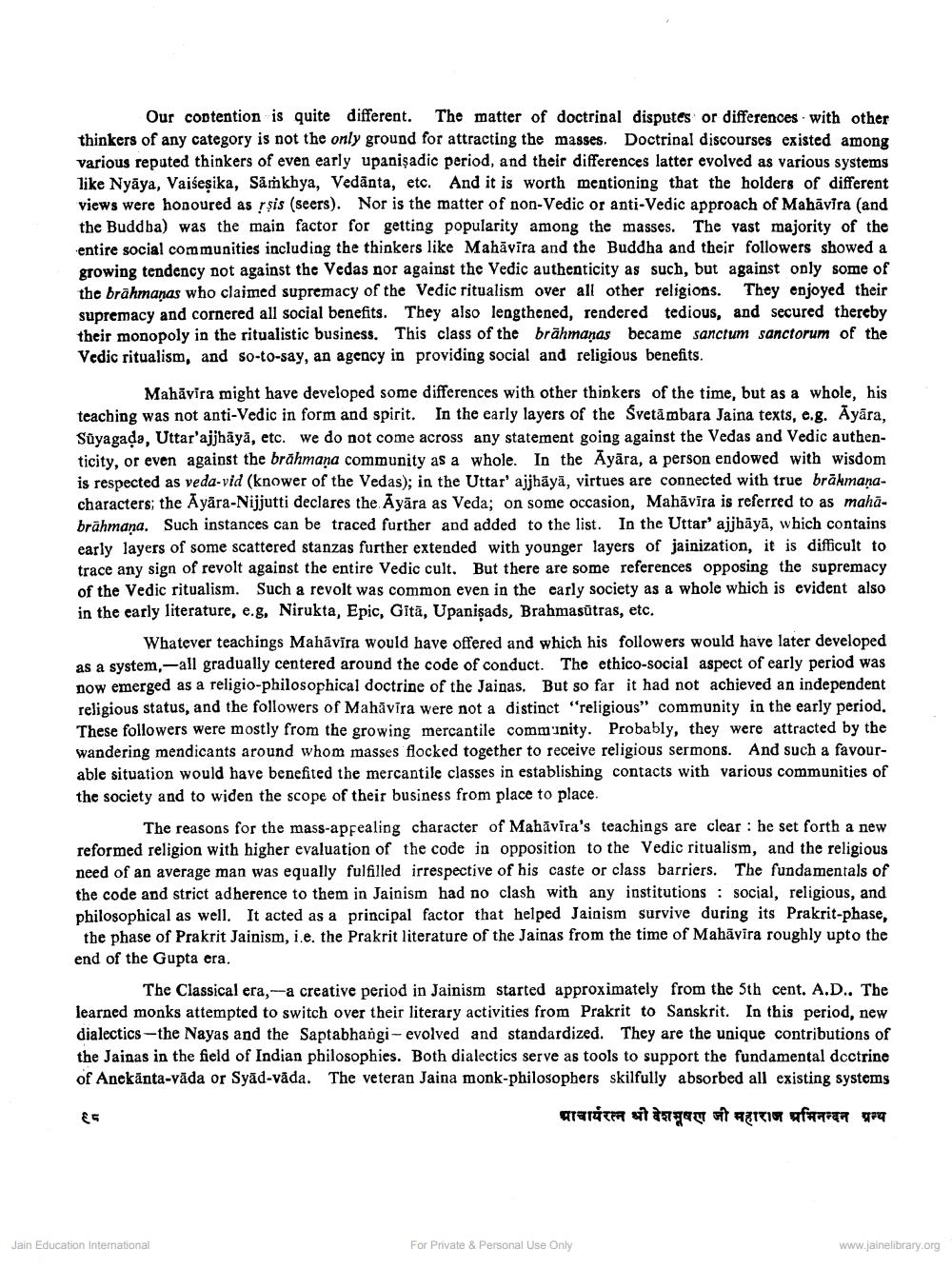Book Title: Survival of Jainism Author(s): Bansidhar Bhatt Publisher: Z_Deshbhushanji_Maharaj_Abhinandan_Granth_012045.pdf View full book textPage 2
________________ Our contention is quite different. The matter of doctrinal disputes or differences with other thinkers of any category is not the only ground for attracting the masses. Doctrinal discourses existed among various reputed thinkers of even early upanişadic period, and their differences latter evolved as various systems like Nyāya, Vaiseșika, Samkhya, Vedānta, etc. And it is worth mentioning that the holders of different views were honoured as rşis (seers). Nor is the matter of non-Vedic or anti-Vedic approach of Mahāvira (and the Buddba) was the main factor for getting popularity among the masses. The vast majority of the entire social communities including the thinkers like Mahāvīra and the Buddha and their followers showed a growing tendency not against the Vedas nor against the Vedic authenticity as such, but against only some of the brahmanas who claimed supremacy of the Vedic ritualism over all other religions. They enjoyed their supremacy and cornered all social benefits. They also lengthened, rendered tedious, and secured thereby their monopoly in the ritualistic business. This class of the brahmanas became sanctum sanctorum of the Vedic ritualism, and so-to-say, an agency in providing social and religious benefits. Mahāvira might have developed some differences with other thinkers of the time, but as a whole, his teaching was not anti-Vedic in form and spirit. In the early layers of the Svetā mbara Jaina texts, e.g. Ayāra, Süyagada, Uttar'ajjhāyā, etc. we do not come across any statement going against the Vedas and Vedic authenticity, or even against the brähmana community as a whole. In the Ayāra, a person endowed with wisdom is respected as veda-vid (knower of the Vedas); in the Uttar' ajjhāyā, virtues are connected with true brālmanacharacters; the Ayāra-Nijjutti declares the Āyāra as Veda; on some occasion, Mahāvīra is referred to as mahabrāhmana. Such instances can be traced further and added to the list. In the Uttar' ajjhāyā, which contains early layers of some scattered stanzas further extended with younger layers of jainization, it is difficult to trace any sign of revolt against the entire Vedic cult. But there are some references opposing the supremacy of the Vedic ritualism. Such a revolt was common even in the early society as a whole which is evident also in the early literature, e.g, Nirukta, Epic, Gitā, Upanişads, Brahmasūtras, etc. Whatever teachings Mahāvīra would have offered and which his followers would have later developed as a system,-all gradually centered around the code of conduct. The ethico-social aspect of early period was now emerged as a religio-philosophical doctrine of the Jainas. But so far it had not achieved an independent religious status, and the followers of Mahāvīra were not a distinct "religious" community in the early period. These followers were mostly from the growing mercantile community. Probably, they were attracted by the wandering mendicants around whom masses flocked together to receive religious sermons. And such a favourable situation would have benefited the mercantile classes in establishing contacts with various communities of the society and to widen the scope of their business from place to place. The reasons for the mass-appealing character of Mahavira's teachings are clear: be set forth a new reformed religion with higher evaluation of the code in opposition to the Vedic ritualism, and the religious need of an average man was equally fulfilled irrespective of his caste or class barriers. The fundamentals of the code and strict adherence to them in Jainism had no clash with any institutions : social, religious, and philosophical as well. It acted as a principal factor that helped Jainism survive during its Prakrit-phase. the phase of Prakrit Jainism, i.e. the Prakrit literature of the Jainas from the time of Mahāvira roughly upto the end of the Gupta era. The Classical era,--a creative period in Jainism started approximately from the 5th cent. A.D.. The learned monks attempted to switch over their literary activities from Prakrit to Sanskrit. In this period, new dialectics-the Nayas and the Saptabhangi - evolved and standardized. They are the unique contributions of the Jainas in the field of Indian philosophies. Both dialectics serve as tools to support the fundamental doctrine of Anekānta-vāda or Syād-vāda. The veteran Jaina monk-philosophers skilfully absorbed all existing systems प्राचार्यरत्न श्री वेशभूषण जी महाराज अभिनन्दन अन्य Jain Education International For Private & Personal Use Only www.jainelibrary.orgPage Navigation
1 2 3 4 5 6
